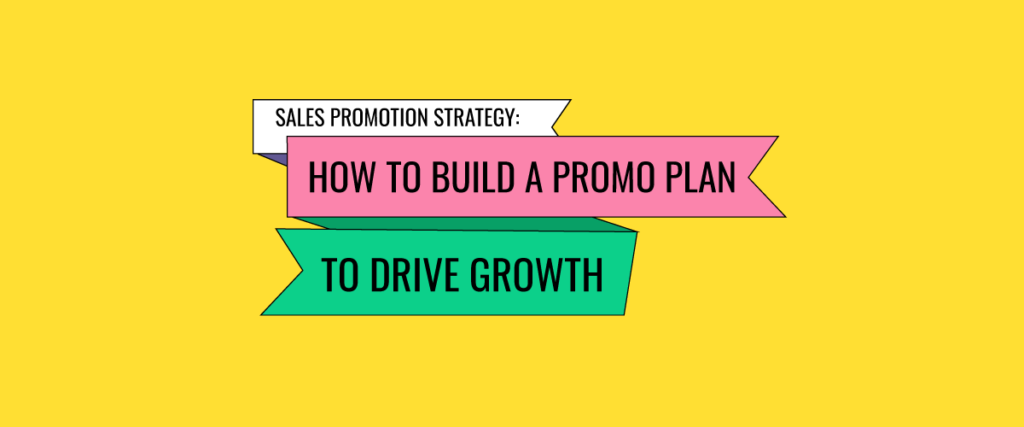In 2021, your eCommerce sales promotion strategy (or lack thereof) can do one of two things:
- Drive conversions, boost average order value, improve customer retention and lifetime value, preserve brand equity, protect margins and profitability, and optimize ROI on virtually every digital marketing channel,
OR - Leak conversions and sales, erode brand value perception, train customers to only buy at a discount, eat away at profit margins and profitability, provide a poor customer experience, drive up shopping cart abandonment and harm customer lifetime value metrics.
I’m going to hedge a bet that you want your promo and discounting strategy to land in the first camp.
This guide will help you understand the goals, benefits, and elements of strong sales promotion strategies, so your team can craft a plan to improve every eCommerce conversion metric that matters in 2022.
What is a Sales Promotion Strategy
A sales promotion strategy, also referred to as a discounting strategy, is a marketing approach to motivating customers to take a specific, pre-determined action through sales discounts, incentives, or offers.
Your promotions strategy isn’t just the marketing campaigns you run and it’s not limited to discounts and holiday promotions.
While those are part of the strategy, your overarching plan needs to take into account dynamic, evergreen, and personalized promotions as well.
Many resources state that the purpose of setting a sales promotion strategy is to acquire new customers, but this is a weak approach. Customer acquisition is certainly a benefit of a solid strategy, but the best promo strategies build in sales promotions for every stage of the marketing funnel.
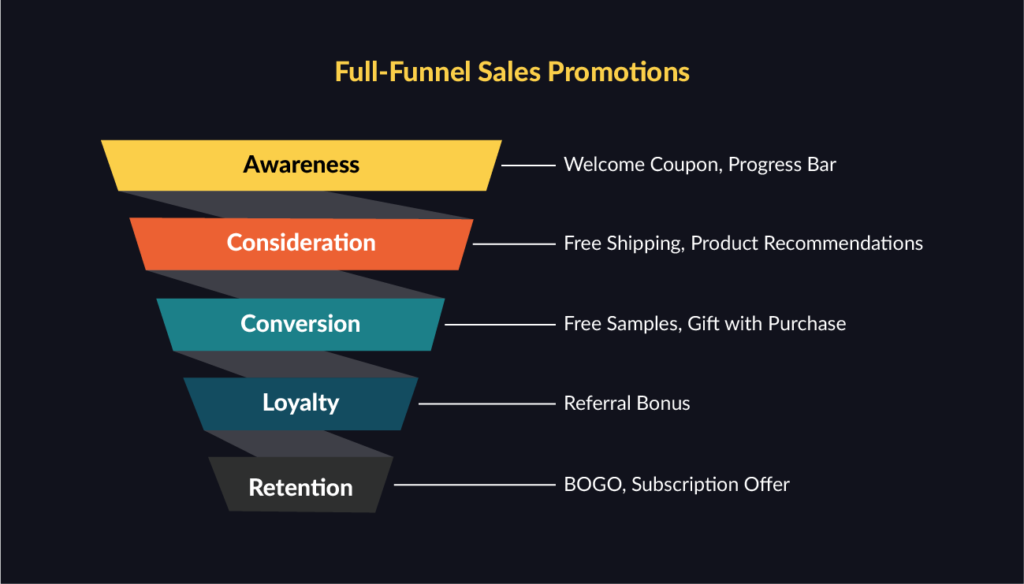
A sales promotion strategy is sometimes referred to interchangeably as a marketing campaign strategy, though this is a misnomer; a marketing campaign doesn’t necessarily need to have a sales promotion attached to it.
It would be more accurate to say that your incentivized marketing campaigns would be built into your sales promotion strategy, so it’s a piece of the puzzle but not the entire picture.
Why Take a Strategic Approach to Sales Promotions
The goal of any eCommerce sales promotion strategy is to engage with the customer in the exact way they need to be engaged with to encourage customer journey continuity.
Sure, the goal of a specific promotion you’re running within the strategy may be more granular than the goal of your overall strategy.
For example, you might run a limited time BOGO offer with the goal of clearing out seasonal inventory or drive repeat purchases to improve customer retention with a 20% discount.
Read: 12 Sales Promotion Examples That Convert
But your overall sales promotion program goes beyond customer acquisition and conversions.
Executing a well-crafted, data-driven strategy will help to improve virtually all conversion funnel metrics while protecting brand equity and profitability.
The Benefits of Crafting a Strategic Sales Promotion Strategy
Let me guess…
Between:
- A/B testing
- Running marketing campaigns
- Prioritizing growth experiments
- Launching new products
- Measuring and optimizing key eCommerce KPIs
- Managing several marketing channels
Plus recruiting, hiring, onboarding, online merchandising, managing contractors and a million other things, your team has a lot on it’s plate.
It’s easy to take a set-it-and-forget-it approach to your promo strategy so you can focus your resources on other demands.
10% welcome coupon, a Black Friday BOGO sale, offering free shipping across the board… why make it more complicated than it needs to be?
But taking a strategic approach to your sales promotions is a crucial aspect of your marketing program, and comes with a host of benefits that provide an upside to the health of the company’s eCommerce channel.
Benefits like:
![Benefits of a Sales Promotion Strategy [infographic]](https://www.namogoo.com/wp-content/uploads/2021/02/sales_blog_images-02-02-1024x823.png)
Let’s break them down:
Conversion Rate Optimization at All Stages of the Marketing Funnel
Increased Margins
Improved Customer Lifetime Value and the Customer Lifecycle
Greater Profitability and Marketing Channel ROI
Preserved Brand Perception
Provides an Excellent Customer Experience
#1. Conversion Rate Optimization at All Stages of the Marketing Funnel
Ahh, conversion rate optimization.
Every marketing team’s holy grail, the eCommerce buzz phrase of the century, CRO is the most coveted benefit to taking a strategic approach to your offers, discounts, and sales promotions.
Note that I didn’t say that “increasing conversions” is the benefit. That’s because a bulletproof sales promotion strategy doesn’t just increase conversions, it truly optimizes for every possible conversion scenario based on a number of factors.
Trying to optimize only sales conversions will leave potential future revenue and brand equity on the table.
After all, first-time visitors to your online store are the least likely to convert, so you need to engage with them differently than repeat customers. The best-laid sales promotion strategies will help you do this.
#2. Boosts Margins
If you were to put everything in your eCommerce store on a sale of 40% off, it would probably convert really well, no matter your pricing strategy, especially if it was a limited time offer.
But there’s a reason this isn’t a sales promotion you see very often, except for maybe during Cyber Weekend: most companies can’t do this profitably.
The greater your margins are, the more you have to spend on marketing and growth, driving more customers to your site.
A solid promo strategy will help you maximize your margins and boost your profitability so your digital marketing program is sustainable over the long term.
#3. Improved Customer Lifetime Value and the Customer Lifecycle
The higher the discount your first-time customers buy your products at, the lower their customer lifetime value.
Read that again.
Higher discounts breed lower value customers.
And it makes sense, too. If your customer’s first purchase with your brand comes with a 20% discount, why would they want to pay full price the next time?
More likely, if they return to your eCommerce store, they’ll leave without converting when they don’t see a similar discount onsite, stopping their lifetime value in its tracks.
A solid sales promotion strategy improves customer retention and lifetime value in two ways:
- It builds in different types of promotions depending on where the customer is in their customer journey. This means that brand new visitors won’t see steep discounts for products they’re just discovering, and your existing, loyal customers won’t see your welcome coupon.
- It helps you to introduce the right product mix at the right time in their buyer’s journey. Your brand new customers won’t see a B2G1 offer for an advanced product they’ve never tried before, and your loyal customers won’t be asked to sign up for your email list.
#4. Protected Profitability and Marketing Channel ROI
Every eCommerce marketing team knows the struggle of trying to craft marketing campaigns and offers that are effective at driving conversions without margins taking a hit, especially on paid channels.
It can be tough! Your 10% welcome coupon seems reasonable for first-time visitors that come from organic search, but when you have to pay for that traffic through paid search, paid social media, or affiliate marketing, your margins quickly crumble.
Check out the impact of a 10% discount on the return for these marketing channels, even at strong margins of 40%:
 Here’s what happens when you reduce the discount to 0%:
Here’s what happens when you reduce the discount to 0%:
 With these inputs, your paid acquisition channels go from taking a loss to being profitable.
With these inputs, your paid acquisition channels go from taking a loss to being profitable.
>> Get the promo profitability calculator free
Since customers coming from paid acquisition channels are most likely to have a high intent to buy, you may not need to offer them a welcome discount to win the sale.
Doing so would only reduce your return and therefore the effectiveness of the marketing channel.
A strong sales promotion strategy will take into account the channel through which customers are being acquired, and profitably offer them the incentive that they’re most likely to act upon.
#5. Preserves Brand Perception
Brand perception is the way your customers view your brand, and what they believe about it.
Online shopping has changed brand perception, stripping companies of some of the control around that perception that they had.
Brand perception now comes from everything from the UX/UI of your online store, to what your customers are saying about the brand on social media, to the reviews of your products and yes, your sales promotion strategy.
It used to be that you could run a heavy sales promotion and only those who stopped by your store or perhaps received a flyer in the mail would know about it.
That worked in the retailer’s favor, as repeated exposure to heavy discounts can harm customer perception of your brand. The more favorably your target customer perceives your brand, the more likely they are to become a loyal customer, at full price or otherwise.
But now, every offer you make, marketing campaign you launch and promotional discount you run could be accessible, recalled and distributed to customers. Unless you have a solid sales promotion strategy that builds in a data-driven approach to segmentation and personalization.
#6. Provides an Excellent Customer Experience
Online, customer experience is everything.
Your team is working hard to reach the right target customers with your marketing campaigns and channels, and drive those ideal customers back to your website. Unless you provide an excellent customer experience onsite, your work is wasted.
Your customer’s experience with your brand online starts before your potential customer even lands on your website, with the channel they’re coming from, and how you target them.
To illustrate how a sales promotion strategy can improve the customer experience, let’s take a look at two scenarios:
- Scenario A: A common customer journey with an eCommerce brand that takes a typical approach to running sales promotions
- Scenario B: A customer journey with a brand that has optimized their sales promotion strategy.
Scenario A:
- Jessica just had her first baby four months ago. She’s browsing Facebook and sees some content about planning a baby’s first birthday party.
- After reading the content on Facebook, she clicks onto the link at the bottom of the Facebook post, which brings her to a website selling baby party supplies.
- She’s served a 30% off coupon code when she lands on the site. Since Jessica’s baby is only four months old, she has very low intention to purchase party supplies for 8 months in the future, so she leaves the website after less than a minute of browsing.
- The next day, Jessica is retargeted with an Instagram ad with a Buy More, Save More offer for the same party supply store.
- Jessica does not convert, but makes a mental note that, when she is ready to buy, she should expect a heavy discount.
This is a typical customer journey. So what’s the problem?
First of all, Jessica’s purchase intention is low. When she initially landed on the site, instead of being led to signing up for the email newsletter or driven to a content page to engage her where she’s at, she was shown a sales incentive (30% off) for a product she’s not interested in buying just yet.
Then, when Jessica leaves the site, she sees an ad for another offer all together, for a heavier discount the more she buys. The offer is still irrelevant to her at this stage of her customer journey, and damaged her value perception of the brand for the future.
In this scenario, Jessica would have never clicked on the ad. But if she had, it’s likely the website would have provided a disconnect between customer expectation and actual experience, because Jessica probably would have seen the 30% off coupon again. It’s extremely common for even savvy, large eCommerce sites to take a one-size-fits-all approach to sales promotions onsite.
Now check out the next scenario.
Scenario B:
- Nick is proudly sporting a new beard. New to facial hair, he searches Google for information on how to shave his neckline. He finds Dollar Shave Club’s article on the topic and clicks onto the article:
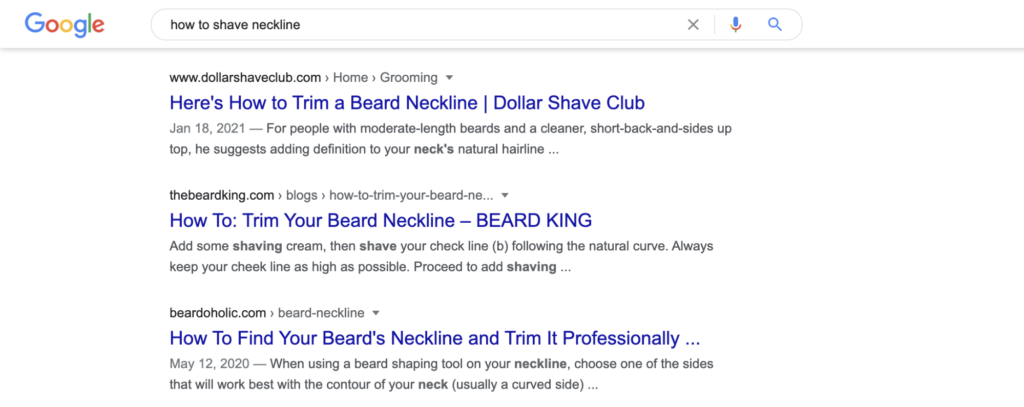
- His purchase intent is low at this point, as he’s gathering information. Since he’s unlikely to convert during that session, he doesn’t see any sales promotions on the page. After reading some of the article, Nick leaves the website.
- Later that day, Nick is browsing Instagram from his phone on his commute home from work. In his Instagram Stories feed, he is retargeted with an ad for Dollar Shave Club’s products.
- Nick clicks on the ad, and is taken to the website, where he sees an offer for 10% off his first order. He sees this offer because multiple data points predict that his purchase intention is high, and that he doesn’t need a huge discount to convert for the first time.
- Nick navigates through to a product page where he also sees a complimentary product that he would benefit from. He puts both in his cart, and checks out.
Do you want to be treated like a Jessica, or a Nick?
Nick’s customer experience was far better than Jessica’s, which ultimately led to not only his conversion but an increase in cart size, and the likelihood that he’d be retained as a customer (and potentially even refer a friend).
The optimal sales promotion strategy provides an excellent customer experience through segmentation and personalization. You’ll see what I mean in the next section.
How to Build an Ecommerce Sales Promotion Strategy
Okay, you know you need a rock-solid promotion strategy. Check.
So what do you need to build into your strategy for it to pay compound interest for your team?
There are four steps to developing an optimized strategy so you can reap the rewards: the why, what, who, and how.
Armed with data, you can build your customer segments and begin to craft your eCommerce sales promotion strategy.
- Why: Setting the strategic objectives of your promotion program
- What: The sales promotions and incentives you’ll offer
- Who: Which customers you’ll offer each promotion to
- How: How you’ll display and communicate the promotion to the customers you’re planning on offering.
Let’s dive into each step so you can begin to build your strategy today
Step #1: Set Objectives and Key Results for Your Sales Promotion Strategy
The first step of developing any strategy is to set objectives for the plan.
Note I didn’t say goals. Goals won’t help you develop the strongest possible strategy for your promotions. OKRs will.
Objectives and Key Results (OKRs) is the goal-setting strategy of Google, Intel and dozens of other top-performing companies.
Setting OKRs is more effective at building sustainable, healthy teams and channels than setting goals (yes, even SMART goals) because goal setting treats each goal as a standalone target, rather than a part of a network of factors that influence one another.
By focusing on achieving goals, no matter how smart they are, you could be “robbing Peter to pay Paul”.
Not sure what I mean? Here’s an example.
SMART Goal Setting: Say your goal for your promotion strategy was to increase your eCommerce conversion rate by 20% (from 2.5% to 3%) by the end of the quarter. You could do so in a number of ways, many of which may harm the long term health of your business. For example, you could:
- Bump your welcome coupon up to 25% off for first-time customers, but dipping into your margins
- Overspend on Facebook ads to bring high-converting traffic to the site but hurting profitability of your paid acquisition channel
- Give away a free product with every purchase that might get customers to convert, but hurt customer retention and LTV.
Setting Objectives and Key Results: Objectives zoom out of specific goals, and instead focus on the ideal outcomes; what needs to be achieved by a project, team or strategy. When setting OKRs, the SMART goal in our example above becomes one key result of the strategic objective. The outcome this team is looking for is likely long term, sustainable revenue growth, not quick-hit conversions.
Below, we’ll get into how to set both objectives and key results to set your strategy up for success before even launching your first promotion.
Objectives
Setting objectives determines how you’ll measure the strategy’s success. Aim to set strategic objectives that encompass the desired benefits of your strategy.
After you’ve set your objectives, you’ll determine which key results and metrics will measure whether you’re successful in reaching it.
Your objective should be the desired outcome of your strategy, and the key results (KRs) are metrics to track to reach the goal.
Examples of Sales Promotion Objectives
Remember, this is not the time to focus on a single metric you would like to see improvement on. Single metric improvements should be captured in your KPI targets.
The best strategies focus on achieving 2-3 objectives. Too many goals and objectives and you’ll set yourself up for failure.
Here are some examples of objectives to set for your sales promotion strategy:
- Improve customer experience through personalized promotions
- Boost customer journey continuity through an improved conversion funnel
- Improve customer retention and reduce churn
- Increase eCommerce channel profitability.
Each objective encompasses several conversion goals, and if achieved, will necessarily lead to improvement across the board.
Key Results
John Doerr, author of Measure What Matters, the popular book about OKRs, defines key results as follows:
“Key Results benchmark and monitor how we get to the objective. Effective KRs are specific and time-bound, aggressive yet realistic. Most of all, they are measurable and verifiable.”[*]
So in terms of a traditional goal-setting framework, key results align with what might be considered goals. Set key results that will help you reach the overall objectives of your sales promotion strategy.
Examples of Key Results for Your Promotion Strategy
Using the sample objectives, we’ve indicated the conversion metrics that will help you measure your progress and the effectiveness of your strategy.
The key results that you build around these metrics will be individual to your industry, product, customers, and objectives, but by constructing your key results around these KPIs, you’ll ensure that you’re building a sustainable, profitable strategy.
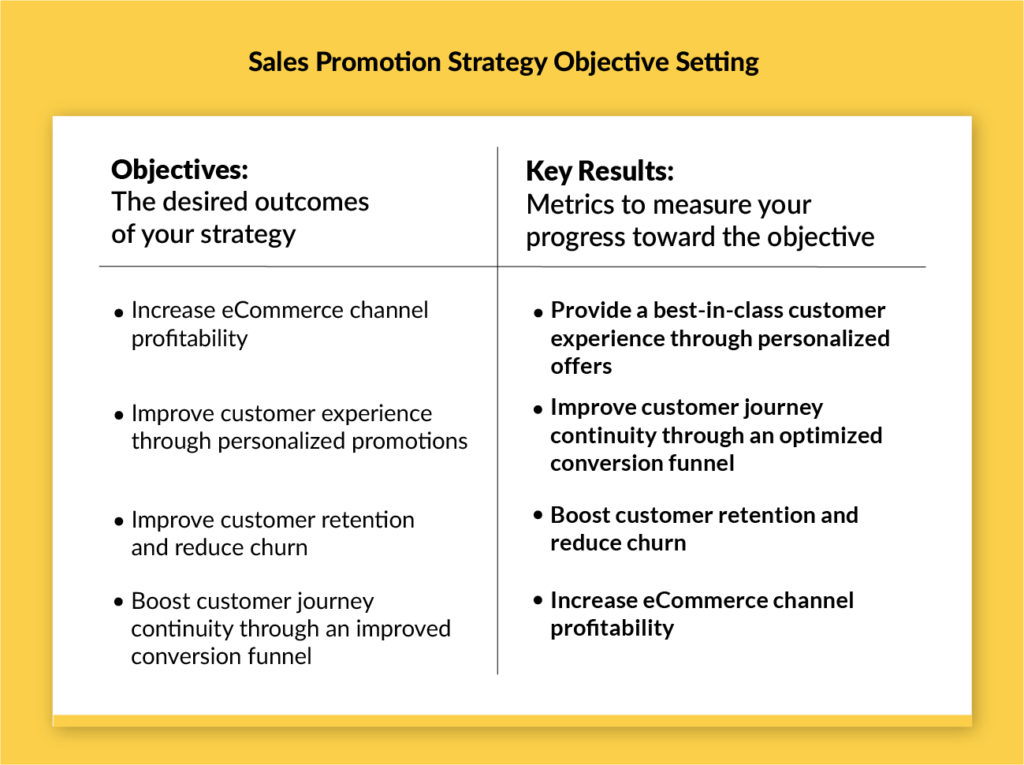
- Provide a best-in-class customer experience through personalized offers
- CVR
- CLTV
- Discount rate
- Cart abandonment
- AOV
- Channel ROI
- Time to purchase
- Improve customer journey continuity through an optimized conversion funnel
- CVR
- Repeat visitors
- Cart abandonment
- CLTV
- Boost customer retention and reduce churn
- CLTV
- Repeat purchases
- Increase eCommerce channel profitability
- RPV
- Discount rate
- AOV
- Shopping cart abandonment
- CVR
Sales Promotion Metrics to Monitor the Health of Your Strategy
There are some metrics to build into your strategy’s Key Results that’ll ensure your strategy is effective, diagnose potential weak spots, and do more of what works.
You’ll want to measure two things:
- Sales Promotion Strategy Metrics: Compare the following metrics to your pre-strategy implementation KPIs to measure the overall effectiveness of your strategy after it’s been running for 3, 6, 9, and 12 months.Look for an improvement in all metrics across the board — some will take a while to become evident (like LTV) while other metrics will show improvement immediately (cart abandonment, for example).This is an example of the strategy-level metrics you have access to in your Intent-Based Promotions dashboard that you’d be wise to build into your key results.
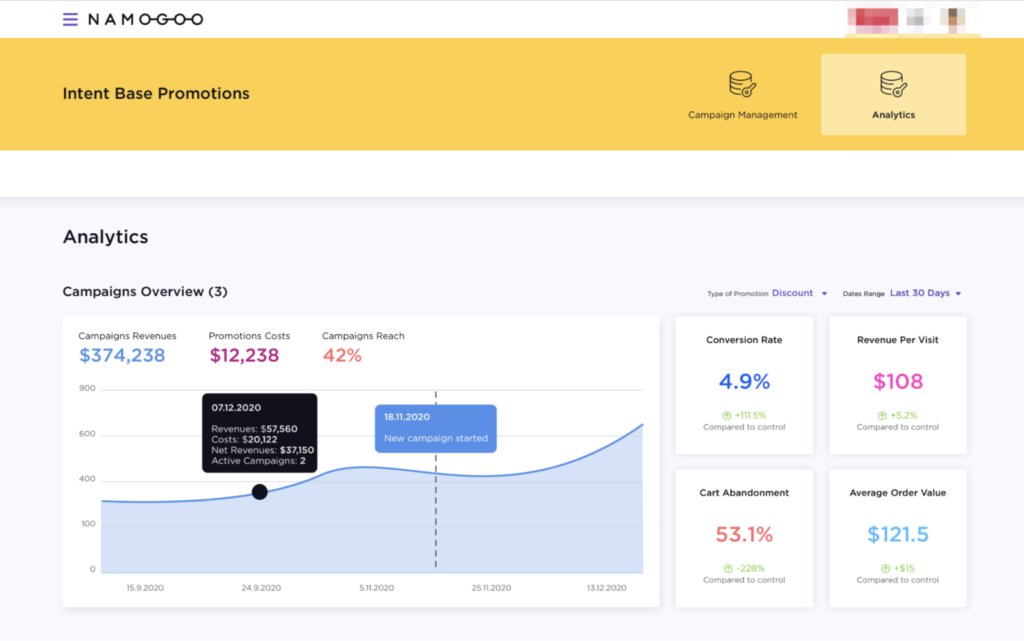
- Campaign Metrics: Unless you dive deeper into the data on a campaign level, you won’t be able to diagnose potential problems, understand opportunities, and tweak the strategy in response. What gets measured gets managed!These metrics won’t necessarily make their way into your strategy’s objectives or key results, but they’ll be important to track, as they’re a piece of the puzzle.Here’s an example from a customer’s Intent-Based Promotions dashboard of campaign-level metrics:

The top KPIs for gauging promotional success are:
- Conversion Rate
- Average Discount & Promotion Costs
- Engaged Conversion Rate
- Abandoned Carts
- Time to Purchase
- Average Order Value
- Revenue Per Visitor
- Promotional Lift
- Average Discounting Rate
- Customer Lifetime Value
Hint: If you’re using Intent-Based Promotions to power your sales promotion strategy, these KPIs are all in your Analytics Dashboard.
After you’ve set the objectives for your sales promotion strategy, and the key results of your objectives, you can move onto determining the price discounts and sales incentives that’ll help you achieve your OKRs
Step #2: Craft Your Price Discounts & Sales Incentive Mix
This step is the one most teams are familiar with, and you may already have a campaign calendar outlining a basic framework of the promotions you plan on running throughout the year.
But you need to build in more than just the discounts attached to your marketing campaigns. There are two basic categories of promotions: evergreen sales incentives and limited-time offers.
Evergreen Sales Incentives
Evergreen incentives are offers and discounts that remain relevant over a sustained period of time. They’re static on your site, and not tied to any particular marketing campaign, season, or holiday.
These promotions are the bread and butter of your strategy. Some examples include:
- Free shipping
- Free samples
- Upsell and cross-sell discounts
- Welcome coupons
- Referral discounts
- Affiliate and partner discounts
- Subscription discounts.
Note that just because they’re evergreen doesn’t mean that all of your customers should have access to all of these promotions continuously.
Customers should be served different offers personalized to their behaviors, demographics and psychographics, intent to purchase and customer journey stage.
Limited-Time Offers
Unlike evergreen sales incentives, limited-time offers are promotions that run for a fixed period of time. They are time-bound and relevant only for a specific event, season, holiday, date, or need.
Here are a few examples of this type of promotion:
- Product launch offers
- Inventory clearout discounts
- Seasonal promotions
- Holiday sales
- Offers related to marketing campaigns.
Both of these promotion types need to be built into your plan, because they work together to achieve the goal of the strategy.
Most teams settle on a marketing campaign calendar and slot in a few holiday and seasonal promotions, and call their plan a strategy.
But without nailing these next two elements down, you’re not thinking strategically to create a sustainable strategy that’ll drive growth.
Step #3: Determine Who Each Promotion Will Be Offered to via Segmentation and Personalization
Not all of your target customers need a promotion to act. Some will buy with no incentive at all; some wouldn’t buy even at a steep price discount.
Applying each promotion to everyone will hurt brand perception, profitability, customer lifetime value, and the long term health of your marketing program.
So, once you have a solid understanding of the price discounts and sales incentives you’re planning on offering, you need to figure out who each will go to. There are three key factors to take into account when setting this.
- Data
- Personalization
- Segmentation.
Don’t skip this step. This is one of the cornerstones of building an effective sales promotion strategy. If you nail this, you’ll reap the benefits mentioned above.
Data
You’ve been there.
You just had a verbal conversation with a friend about how you were considering buying an air fryer, and then a few hours later you see ads all over the internet for air fryers. Feels a bit like you’re being watched by Big Brother, right?
In reality, every action you take on the internet is a data point that can be pulled together and analyzed with millions of other data points collected from people like you, to predict your future purchasing behavior with impressive accuracy.
So when we say that data is a crucial element of your promotion strategy, we really mean that data needs to be an element of your overall marketing strategy; both the collection of data and the utilization of that data.
Without data, you can’t segment your customers and personalize their experience and the promotions they see (at least not in a scalable way).
A good solution would be to ensure you’re collecting data on the customer journey and user onsite behavior and using that data to segment your customers and personalize the promotions they’re exposed to onsite using that data.
But ultimately, even if you see millions of website visitors a year, you’re still limited with the amount of data you can collect by analyzing only your own sessions.
More data is better, especially with behavioral marketing and segmentation.
So a better solution is to bring other site data into the fold.
By considering millions of unique data points from hundreds of large online retail stores is how this (anonymous) customer was able to use Intent-Based Promotions to power it’s sales promotion strategy and increase virtually every metric across the board.
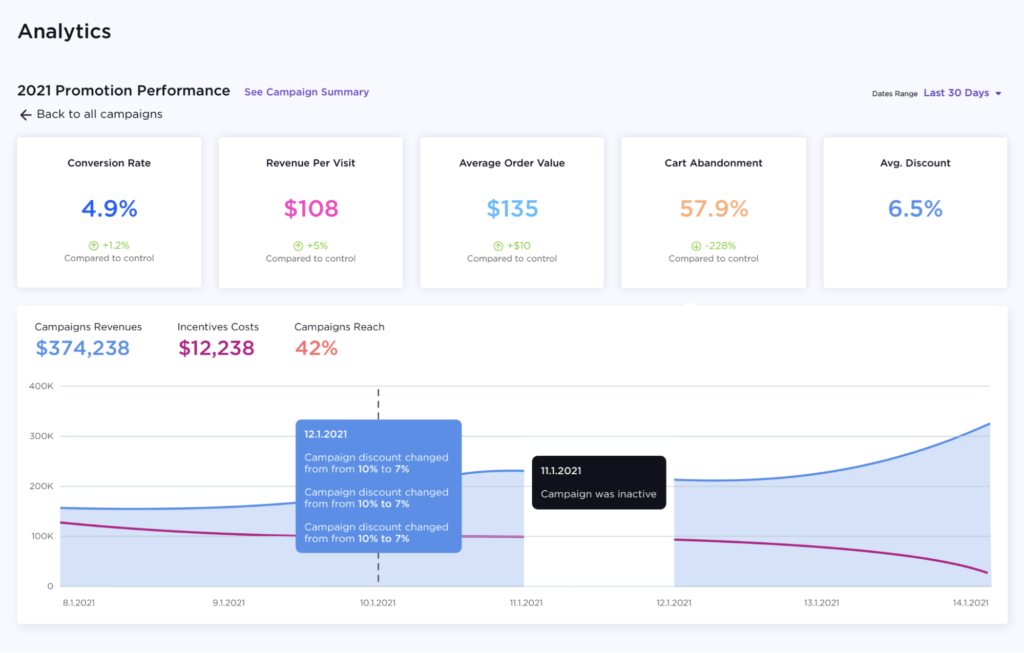 AI and machine learning has made it possible to build robust customer segments and then personalize their customer experience.
AI and machine learning has made it possible to build robust customer segments and then personalize their customer experience.
Segmentation
We started this guide by proposing that a poorly thought out approach to a sales promotion may lead to a leaky sales funnel, the erosion of brand value perception, reduced profitability and a customer lifetime value that you wouldn’t be proud of.
A one-size-fits-all approach to sales promotions is not a winning strategy.
To avoid falling into this promotion trap, you need to lean into customer segmentation.
Customer segmentation isn’t just for email marketing or paid social media. It’s an essential step of any successful marketing strategy.
Unless you use the data you collect to segment your customers, you won’t be able to personalize the customer experience on or offsite, which is the third crucial element to a solid sales promo strategy.
Personalized incentives can increase cart conversion rates by as much as 5-10% and decrease cart abandonment rates by 20%. To capitalize on this, you need to segment.
In the B2C world, there are three main ways to segment customers.
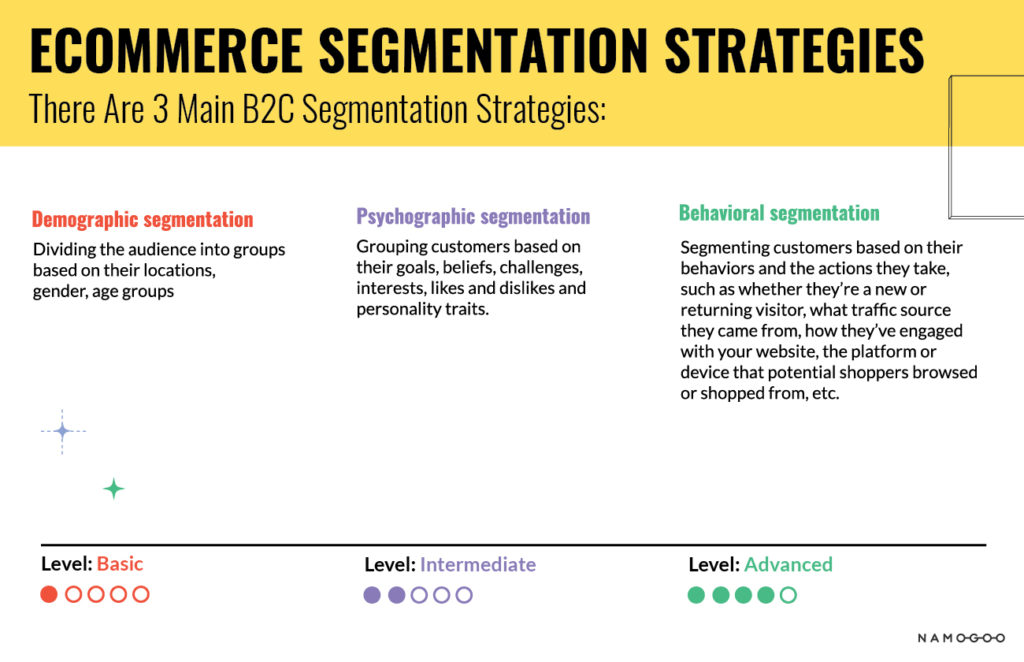
- Demographic segmentation: Dividing the audience into groups based on their locations, gender, age groups.
- Psychographic segmentation: Grouping customers based on their goals, beliefs, challenges, interests, likes and dislikes and personality traits.
- Behavioral segmentation: Segmenting customers based on their behaviors and the actions they take, such as whether they’re a new or returning visitor, what traffic source they came from, how they’ve engaged with your website, the platform or device that potential shoppers browsed or shopped from, etc.
Your promotional strategy needs to consider these customer segments when planning promotions.
Personalization
What if you could personalize your website’s UI/UX to tailor it to each specific visitor?
That would be pretty awesome, right? Conversions would skyrocket, virtually every eCommerce metric would become stronger, and your customers would perceive your brand exactly how you wanted them to.
A customized onsite customer experience might sound out-of-reach, but it’s not just a pipe dream.
This is why Intent Based Promotions exists. It takes into account millions of data-points about customer buying behavior from millions of online shoppers to calculate the purchase propensity and abandonment potential of each visit.
It then autonomously determines the minimum promotion needed to convert (if any), and serves the promotion onsite.
So if you and I landed on the same website at the exact same time, I (a first-time visitor with low price sensitivity and high intent to purchase) might see this:
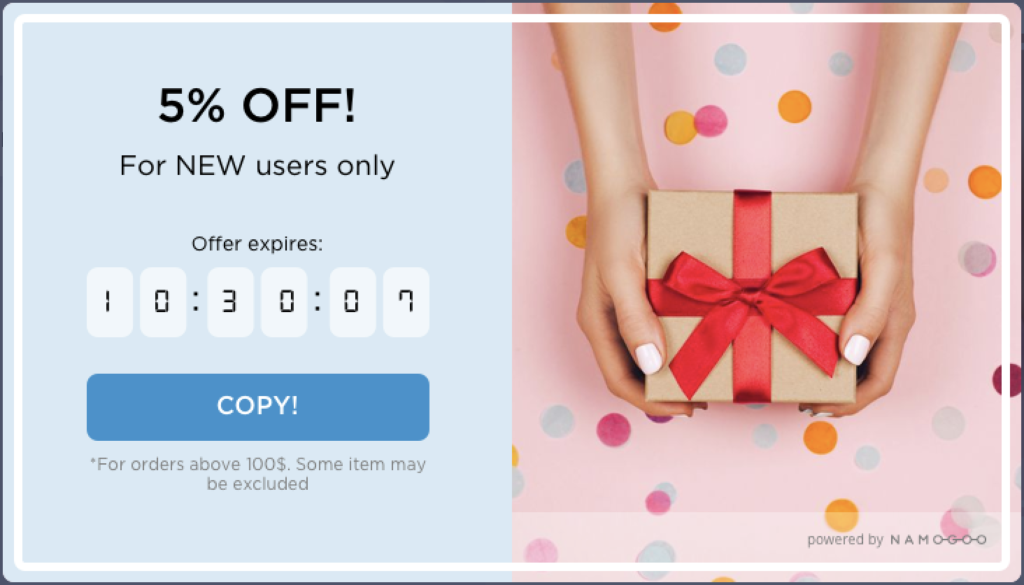 And you (an existing, high-order-value customer who hasn’t purchased in a while and requires an incentive to re-order) might see this:
And you (an existing, high-order-value customer who hasn’t purchased in a while and requires an incentive to re-order) might see this:

Effective personalization in eCommerce marketing isn’t just identifying and treating customers differently, it’s tailoring your sales incentives to them, as well.
Personalize your promotions based on product preference (a psychographic), their purchase intent (a behavior), not just price sensitivity or location (a demographic).
Step #4: Communicate Your Promotions to the Right Customers (at the Right Time)
Once you know which promotions you plan on offering and to whom, you need to get the offer in front of the right customers at the right time in their buyer’s journey.
Hint: if you want to save yourself the headache of trying to figure this piece out on your own, try out Intent-Based Promotions to do it for you autonomously.
There are two methods of communicating the promotion: offsite digital marketing channels, and during the onsite customer experience. Both are necessary elements of your strategy.
Offsite Digital Marketing Channels
If you want to acquire new customers through your sales promotions, you’ll need to do two things:
- Drive awareness to the large majority of your target audience that hasn’t yet visited your website
- Re-engage the potential customers who left your site without converting.
So how you’ll market your promotional campaigns to your target customers to both drive new visitors and retarget non-converting visitors needs to be part of your promotional strategy.
Build the promotions from your strategy into the following marketing channel plans:
- Email marketing
- Paid social media
- SEM
- Affiliate and influencer marketing
- Strategic partnerships.
Be careful to connect the promotion that these customers are seeing offsite to the offer they’re presented onsite if you’re managing this manually. It’s important for the customer experience to be consistent both off and onsite.
Onsite Customer Experience
Segmentation is commonplace online. This is a good thing; it’s important to understand your customer segments for many reasons beyond conversion rate optimization.
But to gain meaningful conversion uplift and customer journey continuity, you need to use more advanced recommendation strategies based on the behavioral data collected for each individual session.
AI is making it possible to personalize the elements of your onsite experience based on this data. Communicate your sales promotions on the following components of your customer’s onsite experience.
- Product pages. If your customers landed on a specific product page with the intent to purchase, all elements on the page should work to lead them to press the “add to cart” button. Depending on the customer’s onsite behavior and segment, your product page can also work double-duty to suggest personalized product recommendations to increase average order value.
- Checkout and cart pages. The final two pages of the conversion funnel, these pages are prime real estate to communicate offers and promotions. Ensure these pages are truly optimized for a personalized customer experience, as cart abandonment is a risk at this stage. Including personalized upsells or crossells on these pages can boost your average order value and cart size. A personalized checkout process can reduce digital shopping cart abandonment rates as well.
- Your homepage. Most eCommerce stores’ homepage is the page that gets the most traffic. It’s also the inflection point of your customer journey. Therefore, it’s the most important page on your eCommerce website. Your homepage should include modals such as exit-intent pop-ups and product recommendations that personalize the customers’ onsite experience, communicate your promotions and campaigns, and move the visitor down the conversion funnel.
- Category and collection pages. Merchandising areas should also absolutely be optimized for the customer experience, making product suggestions, store displays, and promotions more enticing to potential shoppers. When customers land on these pages, they often don’t know exactly what they want, so personalized offers on recommended products can help them flow through your website.
Build a Promotion Strategy That Drives Profitable eCommerce Growth
You now have the framework you need for your team to set a strategy for sales promotion that will not only optimize for conversions at every stage of your customer journey, but will also:
✓ Preserve brand perception
✓ Protect profitability
✓ Reduce customer churn
✓ Increase customer retention and lifetime value
✓ Improve the customer experience.
Now you just need to plug the unique factors of your company, customers, and industry into the framework and begin to execute your new, bulletproof strategy.



